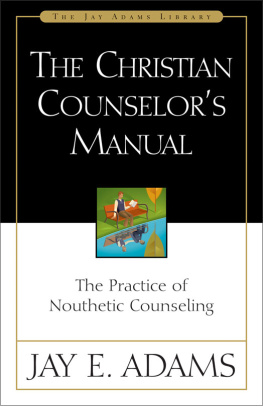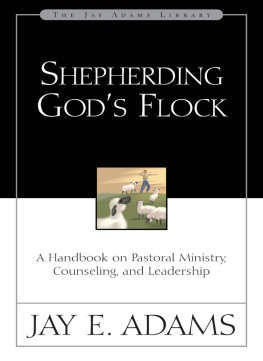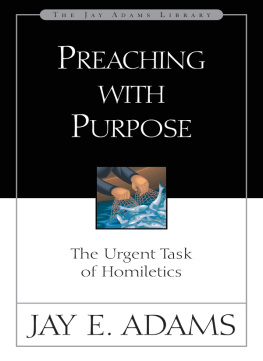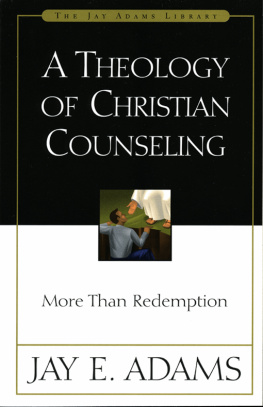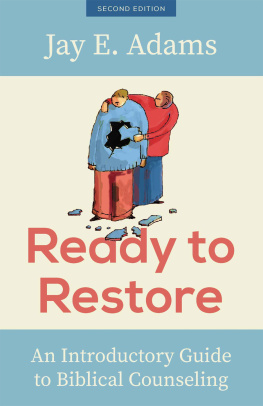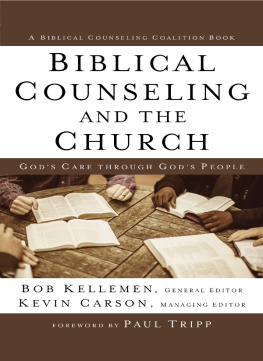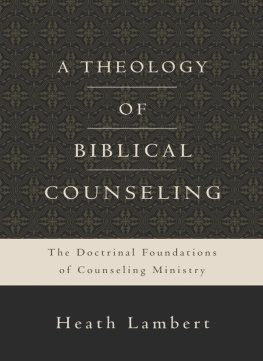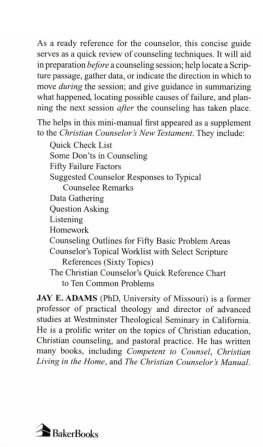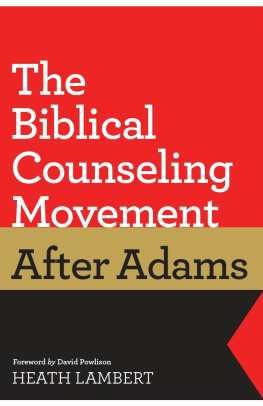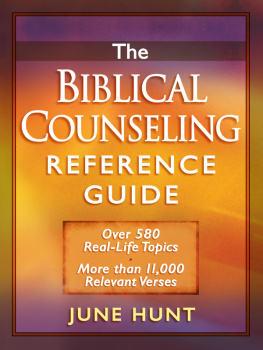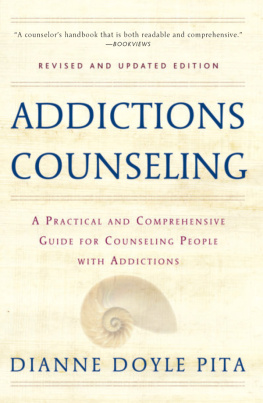This volume is designed to take its place next to Competent to Counsel as its complement, not as a replacement. The two may be used together as textbooks for college or seminary courses. Counselors will find that the reference section at the back of the book provides ready helps to pinpoint possible causes of and biblical solutions for the problems that they confront in the day-to-day work of counseling. Check lists for procedures, failure, etc., have been included to make the ready reference section more profitable. In addition, throughout the reader will find samples of various counseling materials. These may be reproduced by the counselor for use in actual counseling sessions.
I wish to express my deep gratitude to the Rev. William Varner of Willow Grove, Pennsylvania, for preparing the indexes.
I was gratified when the first printing of Competent to Counsel sold out four months after its publication. This interest seems to prove my contention that there is a recognized scarcity of material making a serious attempt to deal with the biblical data concerning counseling and the human difficulties that counseling is concerned to alleviate. Indeed, it was precisely to meet such a need that I wrote. That I was not alone in assuming that conservative ministers would be interested in such a book has been demonstrated to my satisfaction. I was surprised, however, at the number of Christian laymen who also responded with deep interest and concern. This larger response I interpret as a mandate for other volumes that cover additional ground, specialized matters, and advance beyond the first. This present work is one of several in which I seek to fulfil that mandate. The type of readers who have responded with interest has been kept in mind throughout.
Competent to Counsel, while containing a good bit of practical information about the counseling goals, methods, and processes, was, nevertheless, largely polemic. It was important to grapple with the problem and place of Christian counseling in todays world. Of course, very little of that which needs to be done to combat the forces that are impinging upon the Christian counselor was attempted in that volume. It was but an initial attempt. Yet before coming to grips with other antagonists,
In The Christian Counselors Manual I have tried to fill that need to some extent. I know that it is not exhaustive and, D.V., plan to publish additional books covering various areas in more detail in time. I have published The Big Umbrella: Essays and Addresses on Christian Counseling and Christian Living in the Home, books that amplify and supplement what I have tried to cover here. Also, pamphlets, Christ and Your Problems, What to Do About Worry, and Godliness Through Discipline are available as the first of a series of materials designed to assist Christian counselors in the work of nouthetic confrontation. Christ and Your Problems may be given to counselees early in the counseling process, since it is intended to help set conditions for successful counseling by stressing Christian hope and personal responsibility to God. The other two pamphlets are intended to help counselors meet the needs indicated by their titles.
In The Christian Counselors Manual I have built particularly upon the first work, Competent to Counsel, and everywhere assume it. In the scope of this book I have kept in mind my intention to continue to publish materials covering specialized areas of the field of biblical counseling.knowledge of nouthetic confrontation as it has been set forth already. While some matters have been sharpened or amplified, I have not always taken the trouble to make the careful qualifications that I labored to express exactly in the former work. I see no need to paint over the picture again and thereby risk muddying the canvas. If, as a result, I should at places seem brash or appear to take too much for granted, it is probably because I have tried to use bold strokes and vivid colors. After all, I am writing this book for my friends; for those who so enthusiastically responded to my previous efforts. I am not trying to sell anyone here; this is an instruction manual intended principally for those who have already bought the product and wish to make the most effective use of it. The apologetic and polemic notes, therefore, largely will be absent.
May I hasten to say, lest anyone should misunderstand, that in Part Two I have made no attempt to be exhaustive either in depth or in breadth. I do think that the principles considered are vital ones and that what I have said has been discussed fully enough to be helpful, but I must make this clearthe principles are offered more suggestively than comprehensively. They are, in a sense, representative and illustrative as well as (I hope) informative. With those disclaimers and this minimum of orientation, now I should like to introduce you to
PART ONE
THE PERSONS
Chapter One
THE PERSONS INVOLVED IN COUNSELING
Always More Than Two
It is by no means self-evident that the persons involved in pastoral counseling are, as Seward Hiltner has written, the parishioner and pastor or, as nearly every book on counseling assumes, the counselor and the counselee.to enlarge the counseling context fail since, as the Scriptures plainly teach, God holds each one of us personally responsible for his thoughts, words, and actions regardless of external pressures and influences:
For we must all appear before the judgment seat of Christ, that each one [italics mine] may be recompensed for his deeds in the body, according to what he has done, whether good or bad.
All blame-shifting and excuses will evaporate in that day before the searching gaze of the One whose eyes are as a flame of fire. The sophisticated Freudian or behavioristic theories that now seem so conveniently plausible and that are used to justify and excuse men of their responsibility to God will be shown to be futile and false. In His presence, men in anguish will wonder at the naivete that they once called sophistication.
At Least Three
Well then, of whom is the counseling context composed? How many persons are involved and who are they? The Christian answer is that the biblical counseling context, like the disciplinary context (and counseling and discipline must be seen as integrally related), In truly biblical counseling, therefore, where a counselor and counselee meet in the name of Jesus Christ, they may expect the very presence of Christ as Counselor-in-charge.
Chapter Two
THE HOLY SPIRIT IS THE PRINCIPAL PERSON
Jesus Christ now dwells invisibly in His church in the person of the Holy Spirit. Before leaving His disciples, Jesus assured them that the Father would send them another Counselorthe Spirit of truth.
Now, as Jesus was about to leave His disciples, He graciously calmed their fears by informing them that He would send another Counselor like Himself to be with them to teach and guide as He had previously. He identified this Counselor as the Holy Spirit, the Spirit of truth (i.e., who is the Source of truth and who leads into truth).
His Work Is Holiness
The Holy Spirit is called holy not only because He is to be distinguished from all other spirits, and in particular from unclean spirits, but also because He is the Source of all holiness.and His Word without grievously sinning against Him and the counselee. Any counseling context that disassociates itself from these elements is decidedly a non-Christian context, even though it may be called Christian or may be structured by a counselor who is himself a Christian but who has (wrongly) attempted to divorce his Christian faith from his counseling principles and techniques.

